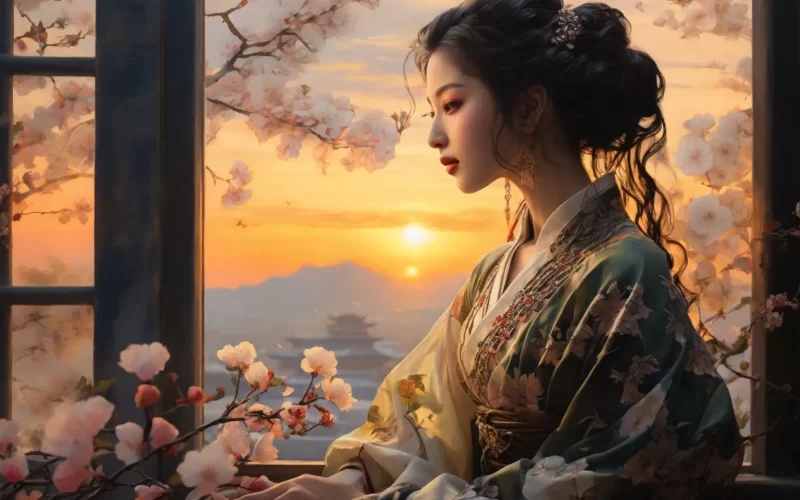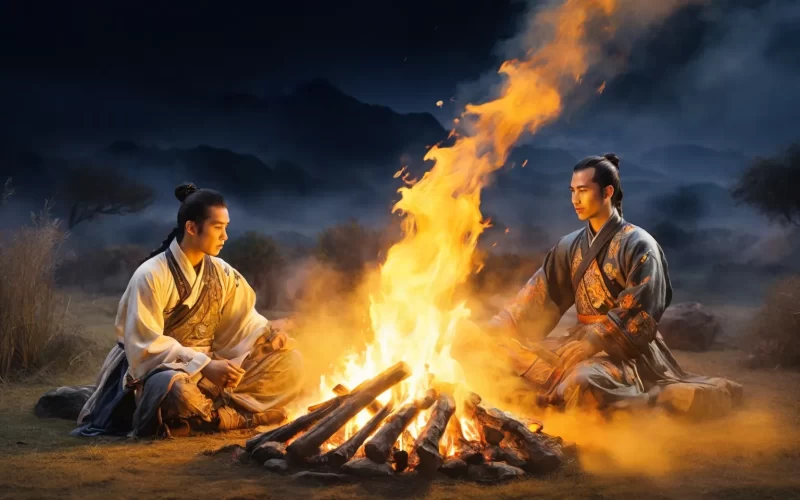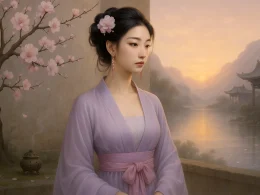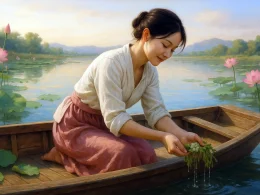With twilight passing her silken window,
She weeps alone in her chamber of gold;
For spring is departing from a desolate garden,
And a drift of pear-petals is closing a door.
Original Poem
「春怨」
刘方平
纱窗日落渐黄昏,金屋无人见泪痕。
寂寞空庭春欲晚,梨花满地不开门。
Interpretation
Composed during the Tang Dynasty, this poem by Liu Fangping stands as a masterful portrayal of a neglected palace maiden's quiet sorrow in the fading light of spring. Through delicate imagery of twilight, seasons, and falling petals, the poet reveals not only the woman's personal grief but also a profound meditation on societal oppression and the capriciousness of fate.
First Couplet: "纱窗日落渐黄昏,金屋无人见泪痕。"
Shā chuāng rìluò jiàn huánghūn, jīn wū wú rén jiàn lèi hén.
Through gauze curtains, the sun sinks into dusk’s embrace; In gilded chambers, none witness the tear-traces.
The opening line traces the slow descent of daylight ("sinks into dusk"), using the adverb 渐 (gradually) to mirror the woman’s deepening solitude. The "gauze curtains" soften the harshness of her isolation, while "gilded chambers" (金屋, once Emperor Wu’s love-trove for Chen Ajiao) now stand hollow—their opulence mocking her abandonment. The "tear-traces" (泪痕) suggest not fresh weeping but residual marks, hinting at sorrow long internalized.
Second Couplet: "寂寞空庭春欲晚,梨花满地不开门。"
Jìmò kōng tíng chūn yù wǎn, lí huā mǎn dì bù kāi mén.
The courtyard lies empty, spring’s end near; Pear petals blanket the ground—still, she bars the door.
Here, desolation expands spatially: the "empty courtyard" (空庭) reflects her emotional void, while "spring’s end" (春欲晚) parallels her fading youth. The "pear petals" (梨花), traditional symbols of purity and transience, become her silent companions in decay. Most haunting is her refusal to "open the door" (不开门)—an act of resignation that transcends literal interpretation. It is both a rejection of the outside world and a symbolic entombment, as she seals herself within her grief.
Holistic Appreciation
In just four lines, the poem traces a palace maiden's psychological journey from resentment to sorrow, embedding emotion within the scenery and movement within stillness. Its structure is meticulously layered, moving from indoors to courtyard, temporal change to emotional depth, shifting from visual twilight to auditory silence, and reflecting inner turmoil through external imagery. With a woman's delicate perspective, the poet voices the tragic fate of women confined in palace depths—both lamenting the neglected lives of the fallen and expressing his own stifled despair. It achieves perfect fusion of "one person, one world; one scene, one emotion," leaving lasting resonance.
Artistic Merits
This poem employs vivid imagery and exquisite structural arrangement to convey profound melancholy. The opening couplet blends scene and emotion, establishing atmosphere before revealing its theme; the subsequent couplet transitions from feeling to setting, using "fallen blossoms" as human symbols and "closed doors" to subtly convey emotion. Symbolic images—"dusk," "waning spring," "carpeted pear blossoms"—not only depict seasonal beauty but also serve as artistic metaphors for human destiny. The language is refined yet unpretentious, deeply emotional yet restrained, creating an artistic style that "expresses movement through stillness and emotion through scenery."
Insights
The poem not only exposes the sorrow of palace women trapped by feudal systems but also reflects humanity's helpless struggle against fate. Today, it still resonates powerfully—behind glamorous facades, how many overlooked loneliness and tears exist? Through the maiden's sigh, the poet reminds us to cultivate empathy for others' plights while confronting our own hidden solitude and longing.
Poem translator
Kiang Kanghu
About the Poet
Liu Fangping(刘方平), whose date of birth and death is unknown, was a native of Luoyang and lived from Tianbao to Dali. Unrecognized for his talent, he lived in seclusion on the shores of the Yingshui and Ru River, and remained unrepresented throughout his life, as he was known at the time. He was a poet and friend of Huangfu Ran. He was a poet and good at painting landscapes.












